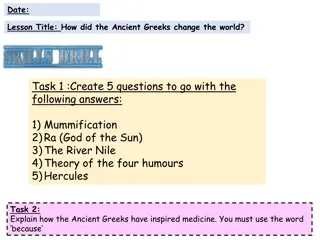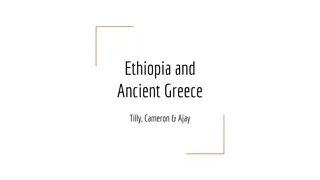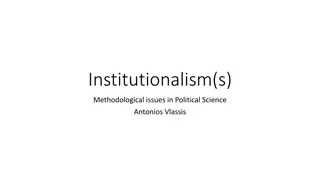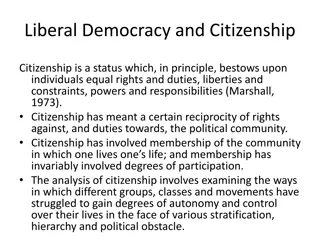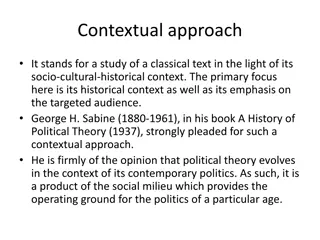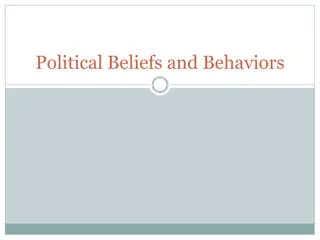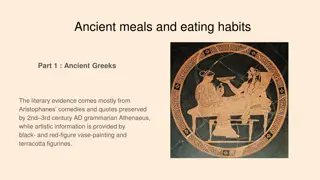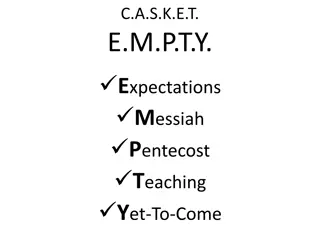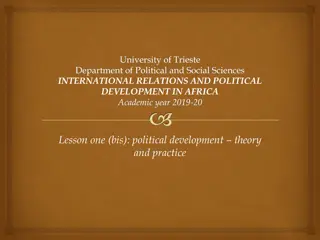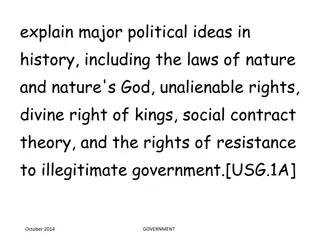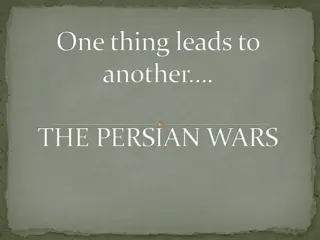Contrasting Political Organizations: Persians vs Greeks
While the Persians focused on building a vast imperial system with a divine king, the Greeks emphasized the unique concept of citizenship and political participation within independent city-states. The Persians ruled through an elaborate administrative structure while the Greeks favored a more democratic approach, especially in Athens. These civilizations differed in their political values and structures, shaping their respective societies significantly.
Download Presentation

Please find below an Image/Link to download the presentation.
The content on the website is provided AS IS for your information and personal use only. It may not be sold, licensed, or shared on other websites without obtaining consent from the author. Download presentation by click this link. If you encounter any issues during the download, it is possible that the publisher has removed the file from their server.
E N D
Presentation Transcript
ANSWER YOUR GIVEN MARGIN REVIEW QUESTION WITH YOUR PARTNER ON THE POSTER PAPER! YOU CAN WORK ON YOUR POSTER UNTIL LUNCH!
Why did some Paleolithic peoples abandon earlier, more nomadic ways and begin to live a more settled life? Around P. 24 Climatic warming allowed many plants and animals upon which humans relied to flourish. The increased food stocks allowed some groups of humans to settle down and live in more permanent settlements.
What was the role of cities in early civilization? AROUND P.69 Political and administrative centers Centers of culture including art, architecture, literature, ritual, and ceremony Marketplaces for both local and long-distance exchange Centers of manufacturing activity
How did Persian and Greeks civilizations differ in their political organizations and values? AROUND P.108 The Persians: built an imperial political system that drew upon previous Mesopotamian polities, including the Babylonian and Assyrian empires. The Persian Empire was far larger than its predecessors, stretching from Egypt to India, and ruled over some 35 to 50 million subjects. system was centered on an elaborate cult of kingship in which the emperor was secluded in royal magnificence and was approachable only through an elaborate ritual. emperors were considered absolute in their power and possessed a divine right to rule by the will of the Persian god Ahura Mazda. Empire was ruled through an effective administrative system that placed Persian governors, called satraps, in each of twenty-three provinces, while lower-level officials were drawn from local authorities. This system was monitored by imperial spies. Persia s rule of its many conquered peoples was strengthened by a policy of respect for the empire s non-Persian cultural traditions.
How did Persian and Greeks civilizations differ in their political organizations and values? AROUND P.108 Greek political organization: was based on hundreds of independent city-states or small settlements of between 500 and 5,000 male citizens. Didn t build an empire but did expand through the establishment of colonies around the Mediterranean Sea and Black Sea. lay in the extent of popular participation in political life that occurred within the city-states. This participation was based on the unique ideas of citizenship, of free people running the affairs of state, and of equality for all citizens before the law. Political participation in Greek city-states was much wider than in Persia, but it varied considerably between city-states and over time. Early in Greek history, only the wealthy and wellborn had the rights of full citizenship, but middle- and lower-class men gradually obtained these rights in some city-states. The widest participation occurred in Athens beginning in 594 B.C.E., when the reforming leader Solon took Athenian politics in a more democratic direction, breaking the hold of a small group of aristocratic families. Debt slavery was abolished, access to public office was opened to a wider group of men, and all citizens were allowed to take part in the Assembly. Later, all holders of public office were chosen by lot and were paid, so that even the poorest could serve. Athenian democracy was direct rather than representative. Even at its height, it was far from universal, with well over half the population, including women, slaves, and foreigners, excluded from participation.
How did Rome grow from a city to the center of a huge empire? AROUND P.118 The values of the Roman republic, including rule of law, the rights of citizens, absence of pretension, upright moral behavior, and keeping one s word along with a political system that offered some protection to the lower classes provided a basis for Rome s empire-building enterprise. Victory in the Punic Wars with Carthage (264 146 B.C.E.) extended Roman control over the western Mediterranean and made Rome a naval power. As the empire grew, each addition of territory created new vulnerabilities that drove further conquests. Poor soldiers hoped for land, loot, or salaries. The well-to-do or well-connected gained great estates, earned promotion, and sometimes achieved public acclaim and high political office by participating in empire building. The wealth of long-established societies in the eastern Mediterranean spurred Roman conquests, as did the resources and food supplies of the less developed western Mediterranean. Rome s central location in the Mediterranean basin made empire building easier. Rome s army was a key to its success. It was drawn from the growing population of Italy and was renowned for being well trained, well fed, and well rewarded. As the empire grew, so did political support in Rome for its continued expansion. This ensured that the necessary manpower and resources were committed to empire building.
Why was the Chinese empire able to take shape so quickly, while the Romans took centuries? AROUND P. 122 the Chinese empire represented an effort to revive an imperial tradition that already existed under the Xia, Shang, and Zhou dynasties. Because of the preexisting imperial tradition in China, the process of creating the empire was quicker, though it was no less reliant on military force and no less brutal than the centuries-long Roman effort. The state of Qin had already developed an effective bureaucracy, subordinated its aristocracy, built a strong military, and enjoyed rising agricultural output using legalist principles. It was able to apply this model to the empire once it succeeded in overcoming the other states. Unlike Rome s transition from republic to empire, the creation of the Chinese empire had only brief and superficial domestic repercussions.
What internal and external factors contributed to the collapse of the Roman and Chinese empires AROUND P. 129 Internal Factors Both empires became too overextended and too expensive for available resources. Neither empire fostered a great technological breakthrough to enlarge resources. Both empires suffered from tax evasion by large landowning families leaving the tax burden to fall heavily onto the poor. Both empires suffered from rivalry between elite factions which created instability. Both empires suffered from epidemics. External Factors Nomadic or semi-agricultural peoples occupying the frontier regions of both empires became growing threats that ultimately conquered portions of both empires.
In what ways did Buddhism reflect Hindu traditions, and in what ways did it challenge them? AROUND P. 160 Buddhism reflected Hindu traditions: in the idea that ordinary life is an illusion, in the concepts of karma and rebirth, the goal of overcoming the incessant demands of the ego, the practice of meditation, and the hope for final release from the cycle of rebirth. Buddhism challenged Hindu traditions: through its rejection of the religious authority of the Brahmins, the lack of interest in abstract speculation about the creation of the world or the existence of gods, and its rejection of the inequalities of a Hindu-based caste system through its belief that neither caste position nor gender was a barrier to enlightenment.
What was distinctive about the Jewish religious traditions? AROUND P. 166 The Jews believe in a single god, whom they called Yahweh. The Jews came to understand their relationship with Yahweh as a contract or covenant. In return for their sole devotion and obedience, Yahweh would consider the Jews his chosen people. Yahweh was increasingly seen as a lofty, transcendent deity of utter holiness and purity, set far above the world of nature, which he had created. Unlike the impersonal conceptions of ultimate reality found in Daoism and Hinduism, Yahweh was encountered as a divine person with whom people could actively communicate. He was also a god who acted within the historical process. Yahweh was also distinctive in that he was transformed from a god of war into a god of social justice and compassion for the poor and marginalized.
How would you compare the lives of Jesus and Buddha? AROUND P. 172 Both became spiritual seekers, mystics in their own traditions, who claimed to have personally experienced another level of reality. Those powerful religious experiences attracted their growing band of followers. Both were wisdom teachers, challenging the conventional values of their time, urging the renunciation of wealth, and emphasizing the supreme importance of love or compassion as the basis for a moral life. Both called for the personal transformation of their followers. Both the Buddha and Jesus were transformed from teachers into gods by their followers.
How would you compare the lives of Jesus and Buddha? AROUND P. 172 Their backgrounds were very different. Jesus was a rural or small-town worker from a distinctly lower-class family, while Gautama was born into a ruling family and was surrounded by luxury. Jesus inherited from his Jewish tradition an intense devotion to a single personal deity with whom he was on intimate terms. According to the New Testament, the miracles Jesus performed reflected the power of God available to him as a result of that relationship. The Buddha s original message largely ignored the supernatural, involved no miracles, and taught a path of intense self-effort aimed at ethical living and mindfulness as a means of ending suffering. Jesus s teachings had a sharper social and more political edge than those of the Buddha. Jesus s public life was very brief, probably less than three years compared to over forty years for the Buddha. It is likely that neither Jesus nor the Buddha planned to found new religions.
In what ways did the 2 religions evolve after the deaths of their founders AROUND P. 172 Their messages emerged soon after their deaths as separate religions proclaimed to much wider and more inclusive audiences. The Christian faith was ultimately promoted as the single legal faith in the Roman Empire. Buddhism, while supported by some rulers, was never promoted to the exclusion of other faiths in India. Both Buddhist and Christian followers clashed over interpretation of their respective founder s teachings. However, Buddhist disagreements generally lacked the clear-cut distinctions defined by right and wrong that Christian disagreements developed.
UNIT 0 EXAM / THURS. 9/26 YOU WILL TURN : 9/ 26 RELIGION CHART GRAPE CIVILIZATION PACKET VOCAB SHORT STORY






